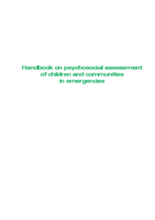People the world over live at risk of disasters – both natural occurrences, such as weather disturbances, volcanic eruptions, earthquakes and tsunamis, and industrial or transportation accidents. As well, war, armed conflict and terrorism also widely threaten communities around the globe. Emergencies are situations in which the lives and welfare of people are at such a risk that extraordinary action must be mobilized to ensure their survival, protection and well-being. The physical consequences of an emergency situation are quite evident: death, disabilities, displacement and much pain. However, the psychosocial consequences are less obvious. While victims’ immediate emotional responses to complex and social emergencies may be detectable, it is much more difficult to know the long-term effects of such events.
Providing psychosocial support to communities and individuals helps them to cope with their emotions and restore well-being. There has been little argument that such support is critical in any society affected by a calamity, but there are concerns regarding its nature. Particularly where international organizations oversee the provision of services, the question often arises: “Are we seeking to impose general, clinical or bio-medical frameworks rather than paying attention to local ways of healing and restoring well-being?” The assessment of the situation before, during and after a disaster or eruption of conflict is crucial in identifying and promoting local or culturally appropriate psychosocial responses that address the needs of children and their families in affected communities. The healing and rebuilding of individuals and families are necessary for the mending and reconstruction of the greater community. Given the noble task and the difficult challenge of addressing the psychosocial consequences of disasters, the essential principle is to encourage healing processes at all levels, fully involving the community in the assessment of a situation in affected areas and in the development of recommendations on psychosocial support empowers that whole community.
Psychosocial self-help and mutual help – as it relates to children and their families – are the cornerstones of this handbook. The fundamental assumption in the development and eventual use of this book is the importance of close collaboration with local or community-based organizations in the assessment of the psychosocial well-being. Depending on the situation, this collaboration entails spending a great amount of time and energy in the field – with the affected people.
This is a guidebook for any agency, organization or academic doing rehabilitation work and focuses on the assessment to be conducted when an emergency first hits or just after a major event in an armed conflict. In these situations, typically a responding agency or group organizes an assessment team of five to eight people who go to the affected area to determine the needs of survivors. This handbook speaks to those assessment teams that focus on the psychosocial as well as physical needs of children, their families and the communities. One of the more important points this handbook stresses is to avoid making children and communities run through the same assessment activities that different teams would hope to conduct. To respect this, coordination is needed among all groups seeking to make psychosocial assessments. If there is no leading response agency or body at first, groups concerned about psychosocial issues should as best as possible coordinate their efforts through a local partner in the affected community. This handbook does not spell out how to achieve that coordination but addresses the preparation needs of an assessment team and what an assessment should concentrate on, including sensitivities and issues to be aware of. This handbook also includes guiding principles and ethics to conducting a community- and child-centered psychosocial assessment. In addition to providing resources, this handbook has the following objectives:
- To be used as a tool for the assessment of the psychosocial well-being of children and families in emergencies;
- To be used as a tool in developing recommendations and strategies that are based on the psychosocial well-being framework; and
- To promote the principles, ethics and techniques that uphold the participatory approach and that build on the resiliency of children, families and communities.
©UNICEF

